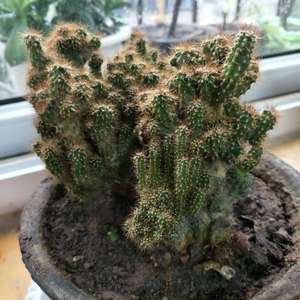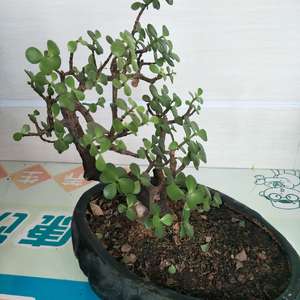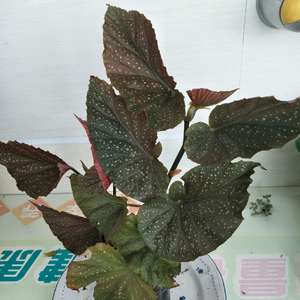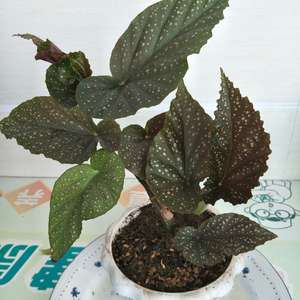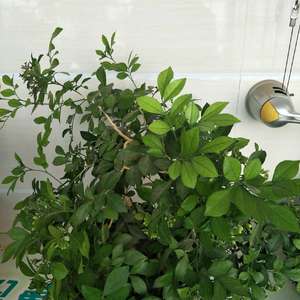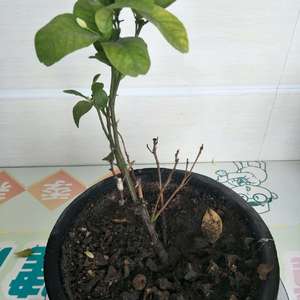文章
Miss Chen
2018年06月25日

Description: This herbaceous perennial wildflower is about 1-2' tall. Alternate compound leaves occur primarily along the lower half of each hairy stem. These leaves are odd-pinnate; they are up to 8" long and 2" across. The lower leaves have 5-7 leaflets, while the sessile upper leaves have 3 leaflets. The terminal leaflet is much larger than the lateral leaflets. The leaflets are coarsely serrated, slightly hairy, rough-textured, and medium green; the terminal leaflet is sometimes divided into 3 lobes. In addition to these leaflets, the lower leaves have tiny secondary leaflets that are inserted between the lateral leaflets.
The upper stems terminate in nodding cymes of flowers. The branches of each cyme are dark purple and very hairy. Each flower is ¾–1" across, consisting of 5 dull red to pale purple petals, 5 dark purple sepals, numerous stamens with yellow anthers, and numerous pistils in the center. Sometimes the inner sides of the petals are pale yellow; regardless of color, they are conspicuously veined. The hairy sepals are ovate in shape; they are about as long as the petals. Between each pair of sepals, there is a linear bract that is dark purple and hairy. The blooming period occurs from late spring to mid-summer and lasts about 1-2 months. Each pistil is replaced by a flattened achene with a long persistent style; the style is hooked toward its tip and often pubescent. The root system is fibrous and rhizomatous. Dense clumps of plants are often formed from the rhizomes.
Cultivation: The preference is partial to full sun, wet to moist conditions, and cool to mild summer temperatures. Various kinds of soil are tolerated.

Range & Habitat: Water Avens is restricted to northern Illinois, where it is rare and native (see Distribution Map). Because this species has not been observed in natural areas of the state for several decades, it may be extirpated because of destruction or degradation of habitat. Water Avens has a circumboreal distribution in North America, Europe, and Asia; northern Illinois lies at its southern range limit. Habitats include White Cedar fens (in Kane County), bogs, marshes, and soggy meadows. This species is sometimes cultivated in gardens.
Faunal Associations: According to Mueller (1873/1883), the flowers produce both nectar and pollen; they are pollinated primarily by bumblebees. Mueller also observed honeybees, long-beaked Syrphid flies (Rhingia sp.), and Sap beetles (Nitulidae) visiting the flowers for nectar or pollen. Because the achenes have persistent styles with hooked or jointed tips, it is possible that they are distributed by birds or mammals.
Photographic Location: A flower garden at the University of Illinois Arboretum in Urbana, Illinois.
Comments: This is one of the more showy species in the genus. Other Geum spp. (Avens) have smaller flowers that are white or yellow. An exception is Geum triflorum (Prairie Smoke), which has nodding red to purple flowers. Unlike Water Avens, the petals of Prairie Smoke are mostly hidden by the sepals. The achenes of Prairie Smoke have long plumose styles that are distributed by the wind. In contrast, the achenes of Water Avens have styles that are jointed or hooked; they are probably distributed by animals, as noted above. Prairie Smoke typically occurs in dry gravelly prairies, while Water Avens is found in various wetland habitats. Another common name of Geum rivale is Purple Avens.
The upper stems terminate in nodding cymes of flowers. The branches of each cyme are dark purple and very hairy. Each flower is ¾–1" across, consisting of 5 dull red to pale purple petals, 5 dark purple sepals, numerous stamens with yellow anthers, and numerous pistils in the center. Sometimes the inner sides of the petals are pale yellow; regardless of color, they are conspicuously veined. The hairy sepals are ovate in shape; they are about as long as the petals. Between each pair of sepals, there is a linear bract that is dark purple and hairy. The blooming period occurs from late spring to mid-summer and lasts about 1-2 months. Each pistil is replaced by a flattened achene with a long persistent style; the style is hooked toward its tip and often pubescent. The root system is fibrous and rhizomatous. Dense clumps of plants are often formed from the rhizomes.
Cultivation: The preference is partial to full sun, wet to moist conditions, and cool to mild summer temperatures. Various kinds of soil are tolerated.

Range & Habitat: Water Avens is restricted to northern Illinois, where it is rare and native (see Distribution Map). Because this species has not been observed in natural areas of the state for several decades, it may be extirpated because of destruction or degradation of habitat. Water Avens has a circumboreal distribution in North America, Europe, and Asia; northern Illinois lies at its southern range limit. Habitats include White Cedar fens (in Kane County), bogs, marshes, and soggy meadows. This species is sometimes cultivated in gardens.
Faunal Associations: According to Mueller (1873/1883), the flowers produce both nectar and pollen; they are pollinated primarily by bumblebees. Mueller also observed honeybees, long-beaked Syrphid flies (Rhingia sp.), and Sap beetles (Nitulidae) visiting the flowers for nectar or pollen. Because the achenes have persistent styles with hooked or jointed tips, it is possible that they are distributed by birds or mammals.
Photographic Location: A flower garden at the University of Illinois Arboretum in Urbana, Illinois.
Comments: This is one of the more showy species in the genus. Other Geum spp. (Avens) have smaller flowers that are white or yellow. An exception is Geum triflorum (Prairie Smoke), which has nodding red to purple flowers. Unlike Water Avens, the petals of Prairie Smoke are mostly hidden by the sepals. The achenes of Prairie Smoke have long plumose styles that are distributed by the wind. In contrast, the achenes of Water Avens have styles that are jointed or hooked; they are probably distributed by animals, as noted above. Prairie Smoke typically occurs in dry gravelly prairies, while Water Avens is found in various wetland habitats. Another common name of Geum rivale is Purple Avens.
0
0
成长记
2B_BotanicalFie
2018年06月24日

I now added "Saxifraga Stolinifera Tricolor (cutting 2)" in my "garden"


0
0
文章
Miss Chen
2018年06月24日

Description: This perennial wildflower is ¾-2½' tall, abundantly branched, and sprawling across adjacent vegetation. The stems are light to medium green, sharply 4-angled and sparsely rough-edged from short stiff hairs. Along these stems are whorls of 4-6 sessile leaves; whorls of 5-6 leaves sometimes occur where the stem branches, otherwise there are 4 leaves per whorl. Individual leaves are up to 1" (25 mm.) long and ¼" (6 mm.) across; they are medium to dark green and narrowly elliptic or narrowly elliptic-oblanceolate in shape. The leaf margins are without teeth and rough-edged from short stiff hairs. There is a single prominent vein per leaf.
Both terminal and axillary cymes of 1-3 flowers are produced. Individual flowers are 1/8" (3 mm.) across or a little less; each flower has a white corolla with 3 (less often 4) spreading lobes, a bifurcated two-celled ovary with a pair of styles, and 3 (less often 4) stamens. The surface of the ovary is green and smooth. The pedicels of the flowers or fruits are up to 1" long, straight, and angular; their edges are smooth. The blooming period occurs during the summer for about 2-3 months. Usually, only a few flowers are in bloom at the same time. Each flower is replaced by a two-celled seedpod that is about 1/8" (3 mm.) across. The seedpod changes color as it matures from green, to purple, and black. Each cell of the pod is globoid-ovoid in shape, smooth, and single-seeded. The root system is fibrous and rhizomatous.
Cultivation: The preference is full or partial sun, wet to moist conditions, and soil containing loam, clay-loam, sand, or gravel. Standing water is readily tolerated if it is temporary.

Range & Habitat: The native Stiff Bedstraw is occasional in northern Illinois, and uncommon or absent in the rest of the state (see Distribution Map). Habitats include marshes, fens, low areas along rivers and ponds, swamps, wet sand prairies, prairie swales, and ditches. Stiff Bedstraw is usually found in higher quality wetlands in Illinois.
Faunal Associations: The flowers are cross-pollinated by flies and small bees. The caterpillars of some moths feed on the foliage or flower tissues of Galium spp. These species include: Epirrhoe alternata (White-Bordered Toothed Carpet), Hyles gallii (Galium Sphinx), Lobocleta ossularia (Drab Brown Wave), and Scopula inductata (Soft-Lined Wave). The species Myzus cerasi (Black Cherry Aphid) uses Galium spp. as summer hosts. Three plant bugs in Illinois are known to feed on these plants: Criocoris saliens, Polymerus proximus, and the introduced Polymerus unifasciatus. White-Tailed Deer browse on the foliage sparingly or not at all. Because the bristly hairs of the stems and leaves can cling to passing objects, animals may play a minor role in spreading the seeds to new locations.
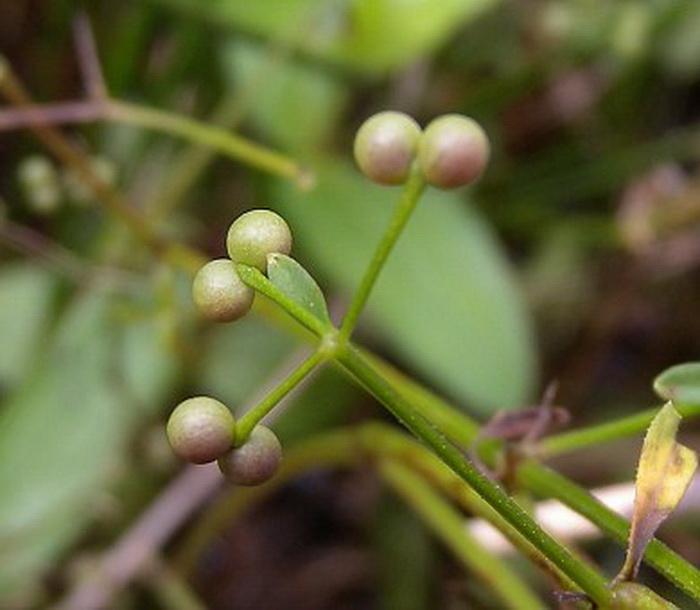
Photographic Location: A wet sand prairie at the Indiana Dunes National Lakeshore in NW Indiana.
Comments: Stiff Bedstraw is unusual because its corollas can have 3-4 lobes on the same plant. In Illinois, the only other bedstraw with 3 lobes on its corollas is Small Bedstraw (Galium trifidum). This latter species is similar to Stiff Bedstraw, but smaller in size and slightly more bristly. In particular, the pedicels of Small Bedstraw are bristly and curved, while those of Stiff Bedstraw are smooth and straight. While Stiff Bedstraw is scattered throughout Illinois, Small Bedstraw is restricted to northern Illinois and a sandy area of central Illinois. This latter species has a more northern distribution and prefers a cool climate.
Both terminal and axillary cymes of 1-3 flowers are produced. Individual flowers are 1/8" (3 mm.) across or a little less; each flower has a white corolla with 3 (less often 4) spreading lobes, a bifurcated two-celled ovary with a pair of styles, and 3 (less often 4) stamens. The surface of the ovary is green and smooth. The pedicels of the flowers or fruits are up to 1" long, straight, and angular; their edges are smooth. The blooming period occurs during the summer for about 2-3 months. Usually, only a few flowers are in bloom at the same time. Each flower is replaced by a two-celled seedpod that is about 1/8" (3 mm.) across. The seedpod changes color as it matures from green, to purple, and black. Each cell of the pod is globoid-ovoid in shape, smooth, and single-seeded. The root system is fibrous and rhizomatous.
Cultivation: The preference is full or partial sun, wet to moist conditions, and soil containing loam, clay-loam, sand, or gravel. Standing water is readily tolerated if it is temporary.

Range & Habitat: The native Stiff Bedstraw is occasional in northern Illinois, and uncommon or absent in the rest of the state (see Distribution Map). Habitats include marshes, fens, low areas along rivers and ponds, swamps, wet sand prairies, prairie swales, and ditches. Stiff Bedstraw is usually found in higher quality wetlands in Illinois.
Faunal Associations: The flowers are cross-pollinated by flies and small bees. The caterpillars of some moths feed on the foliage or flower tissues of Galium spp. These species include: Epirrhoe alternata (White-Bordered Toothed Carpet), Hyles gallii (Galium Sphinx), Lobocleta ossularia (Drab Brown Wave), and Scopula inductata (Soft-Lined Wave). The species Myzus cerasi (Black Cherry Aphid) uses Galium spp. as summer hosts. Three plant bugs in Illinois are known to feed on these plants: Criocoris saliens, Polymerus proximus, and the introduced Polymerus unifasciatus. White-Tailed Deer browse on the foliage sparingly or not at all. Because the bristly hairs of the stems and leaves can cling to passing objects, animals may play a minor role in spreading the seeds to new locations.

Photographic Location: A wet sand prairie at the Indiana Dunes National Lakeshore in NW Indiana.
Comments: Stiff Bedstraw is unusual because its corollas can have 3-4 lobes on the same plant. In Illinois, the only other bedstraw with 3 lobes on its corollas is Small Bedstraw (Galium trifidum). This latter species is similar to Stiff Bedstraw, but smaller in size and slightly more bristly. In particular, the pedicels of Small Bedstraw are bristly and curved, while those of Stiff Bedstraw are smooth and straight. While Stiff Bedstraw is scattered throughout Illinois, Small Bedstraw is restricted to northern Illinois and a sandy area of central Illinois. This latter species has a more northern distribution and prefers a cool climate.
0
0
文章
Miss Chen
2018年06月24日


2.Assemble Materials and Plants
A trip to a full-service garden center will likely provide you with all the materials you need. Or you can order materials (except for the plants) from online retailers. The things you'll need include:
A container with drainage holes (shallow containers are best)
Succulent plants selected to fill container
Plastic window screening (or a piece of landscape fabric or a coffee filter)
Cactus or succulent potting soil
Stones, gravel, sea glass or marbles

3.Cover Drainage Holes
Cut a piece of plastic window screening big enough to cover your pot's drainage holes. This will keep your potting soil in while letting the excess water drain out of the container.
If you don't have window screening, you can use a piece of landscape fabric cut to size or a coffee filter to cover the holes. Although they are a little more expensive, you can also use commercial pot screens, available at garden centers and online retailers.

4.Add Soil
Cover the bottom of the container with enough succulent mix potting soil so that when the plants are placed, the soil line on their stems will remain about 1/2 inch below the rim of the container. This will mark the final soil level, and will make it easier to water without overflowing the sides of the container.

5.Test-Fit the Plants
First, place your plants, still in their nursery pots, into the container to get a general idea of the container design. Move the plants around until you are satisfied with the arrangement. Classic container garden design practice is to make sure that any container garden has a central "thriller" specimen, a group of "filler" plants and others that are "spillers" that flow over the edges of a container. But this arrangement is entirely up to you. Wonderful containers gardens often result from breaking traditional design rules.
0
0



